DokuWiki es una potente aplicación de software Wiki gratuita, de código abierto y escrita en PHP. Utiliza un archivo para almacenar sus datos en lugar de utilizar una base de datos. Es simple, liviano y le permite crear y editar un sitio web desde el navegador web. Ofrece muchas características que le permiten escalar y optimizar su sitio web fácilmente. Es utilizado por muchos usuarios debido a su sintaxis limpia y legible, facilidad de mantenimiento, copia de seguridad e integración.
En este tutorial, le mostraré cómo instalar DokuWiki con Apache y Let's Encrypt SSL en Debian 11.
Requisitos
- Un servidor con Ubuntu 20.04.
- Un nombre de dominio válido apuntado con la IP de su servidor.
- Se configura una contraseña raíz en el servidor.
Cómo empezar
Antes de comenzar, se recomienda actualizar los paquetes de su sistema a la última versión. Puede actualizarlos ejecutando el siguiente comando:
apt-get update -y
Una vez que todos los paquetes estén actualizados, puede continuar con el siguiente paso.
Instalar Apache y PHP
DokuWiki se ejecuta en Apache o Nginx y está escrito en lenguaje PHP. Por lo tanto, deberá instalar Apache, PHP y otras extensiones requeridas en su servidor. Puede instalarlos ejecutando el siguiente comando:
apt-get install apache2 php php-gd php-xml php-json -y
Una vez que todos los paquetes estén instalados, inicie el servicio Apache y habilítelo para que se inicie al reiniciar el sistema:
systemctl start apache2
systemctl enable apache2
Una vez que haya terminado, puede continuar con el siguiente paso.
Instalar DokuWiki
Primero, vaya a la página de descarga de DokuWiki y descargue la última versión de DokuWiki usando el siguiente comando:
wget https://download.dokuwiki.org/src/dokuwiki/dokuwiki-stable.tgz
Una vez completada la descarga, cree un directorio para DokuWiki dentro del directorio raíz web de Apache:
mkdir /var/www/html/dokuwiki
A continuación, extrae el archivo descargado al directorio de DokuWiki con el siguiente comando:
tar -xvzf dokuwiki-stable.tgz -C /var/www/html/dokuwiki/ --strip-components=1
Luego, copie algunos archivos necesarios usando el siguiente comando:
cp /var/www/html/dokuwiki/.htaccess{.dist,} A continuación, establezca la propiedad adecuada en el directorio DokuWiki:
chown -R www-data:www-data /var/www/html/dokuwiki
Una vez que haya terminado, puede continuar con el siguiente paso.
Crea un servidor virtual Apache para DokuWiki
A continuación, deberá crear un archivo de configuración de host virtual de Apache para alojar DokuWiki en Internet. Puede crearlo con el siguiente comando:
nano /etc/apache2/sites-available/dokuwiki.conf
Agregue las siguientes líneas:
<VirtualHost *:80>
ServerName dokuwiki.example.com
DocumentRoot /var/www/html/dokuwiki
<Directory ~ "/var/www/html/dokuwiki/(bin/|conf/|data/|inc/)">
<IfModule mod_authz_core.c>
AllowOverride All
Require all denied
</IfModule>
<IfModule !mod_authz_core.c>
Order allow,deny
Deny from all
</IfModule>
</Directory>
ErrorLog /var/log/apache2/dokuwiki_error.log
CustomLog /var/log/apache2/dokuwiki_access.log combined
</VirtualHost>
Guarde y cierre el archivo, luego habilite el archivo de configuración del host virtual usando el siguiente comando:
a2ensite dokuwiki.conf
A continuación, vuelva a cargar Apache para aplicar los cambios.
systemctl reload apache2
También puede verificar el estado de Apache con el siguiente comando:
systemctl status apache2
Obtendrá el siguiente resultado:
? apache2.service - The Apache HTTP Server
Loaded: loaded (/lib/systemd/system/apache2.service; enabled; vendor preset: enabled)
Active: active (running) since Wed 2021-10-24 04:01:29 UTC; 9min ago
Docs: https://httpd.apache.org/docs/2.4/
Process: 27698 ExecReload=/usr/sbin/apachectl graceful (code=exited, status=0/SUCCESS)
Tasks: 77 (limit: 4691)
Memory: 12.5M
CGroup: /system.slice/apache2.service
??21346 /usr/sbin/apache2 -k start
??27703 Passenger watchdog
??27706 Passenger core
??27711 Passenger ust-router
??27729 /usr/sbin/apache2 -k start
??27730 /usr/sbin/apache2 -k start
Asegure DokuWiki con Let's Encrypt SSL
Después de configurar Apache, se recomienda proteger su sitio wiki con un certificado SSL de Let's Encrypt. Para hacerlo, deberá instalar el cliente Certbot en su sistema. El Certbot es un cliente fácil de usar que obtiene un certificado de Let's Encrypt, una autoridad de certificación abierta lanzada por EFF, Mozilla y otros, y lo implementa en un servidor web. Con el cliente Certbot Let's Encrypt, puede descargar, instalar y renovar fácilmente el certificado SSL para su dominio.
Puede instalar Certbot con el siguiente comando:
apt-get install certbot python3-certbot-apache -y
Una vez que el cliente de Certbot se haya instalado correctamente, ejecute el siguiente comando para instalar Let's Encrypt SSL para su sitio web:
certbot --apache -d dokuwiki.example.com
Se le pedirá que proporcione su correo electrónico válido y acepte el término de servicio como se muestra a continuación:
Saving debug log to /var/log/letsencrypt/letsencrypt.log Plugins selected: Authenticator apache, Installer apache Enter email address (used for urgent renewal and security notices) (Enter 'c' to cancel): [email protected] - - - - - - - - - - - - - - - - - - - - - - - - - - - - - - - - - - - - - - - - Please read the Terms of Service at https://letsencrypt.org/documents/LE-SA-v1.2-November-15-2017.pdf. You must agree in order to register with the ACME server at https://acme-v02.api.letsencrypt.org/directory - - - - - - - - - - - - - - - - - - - - - - - - - - - - - - - - - - - - - - - - (A)gree/(C)ancel: A - - - - - - - - - - - - - - - - - - - - - - - - - - - - - - - - - - - - - - - - Would you be willing to share your email address with the Electronic Frontier Foundation, a founding partner of the Let's Encrypt project and the non-profit organization that develops Certbot? We'd like to send you email about our work encrypting the web, EFF news, campaigns, and ways to support digital freedom. - - - - - - - - - - - - - - - - - - - - - - - - - - - - - - - - - - - - - - - - (Y)es/(N)o: Y Obtaining a new certificate Performing the following challenges: http-01 challenge for dokuwiki.example.com Enabled Apache rewrite module Waiting for verification... Cleaning up challenges Created an SSL vhost at /etc/apache2/sites-available/dokuwiki-le-ssl.conf Enabled Apache socache_shmcb module Enabled Apache ssl module Deploying Certificate to VirtualHost /etc/apache2/sites-available/dokuwiki-le-ssl.conf Enabling available site: /etc/apache2/sites-available/dokuwiki-le-ssl.conf
A continuación, seleccione si desea o no redirigir el tráfico HTTP a HTTPS o configurar Nginx para redirigir todo el tráfico al acceso HTTPS seguro, como se muestra en el siguiente resultado:
Please choose whether or not to redirect HTTP traffic to HTTPS, removing HTTP access. - - - - - - - - - - - - - - - - - - - - - - - - - - - - - - - - - - - - - - - - 1: No redirect - Make no further changes to the webserver configuration. 2: Redirect - Make all requests redirect to secure HTTPS access. Choose this for new sites, or if you're confident your site works on HTTPS. You can undo this change by editing your web server's configuration. - - - - - - - - - - - - - - - - - - - - - - - - - - - - - - - - - - - - - - - - Select the appropriate number [1-2] then [enter] (press 'c' to cancel): 2
Escriba 2 y presione Entrar para iniciar el proceso. Una vez que se complete la instalación, debería obtener el siguiente resultado:
Enabled Apache rewrite module Redirecting vhost in /etc/apache2/sites-enabled/dokuwiki.conf to ssl vhost in /etc/apache2/sites-available/dokuwiki-le-ssl.conf - - - - - - - - - - - - - - - - - - - - - - - - - - - - - - - - - - - - - - - - Congratulations! You have successfully enabled https://dokuwiki.example.com You should test your configuration at: https://www.ssllabs.com/ssltest/analyze.html?d=dokuwiki.example.com - - - - - - - - - - - - - - - - - - - - - - - - - - - - - - - - - - - - - - - - IMPORTANT NOTES: - Congratulations! Your certificate and chain have been saved at: /etc/letsencrypt/live/dokuwiki.example.com/fullchain.pem Your key file has been saved at: /etc/letsencrypt/live/dokuwiki.example.com/privkey.pem Your cert will expire on 2021-01-25. To obtain a new or tweaked version of this certificate in the future, simply run certbot again with the "certonly" option. To non-interactively renew *all* of your certificates, run "certbot renew" - If you like Certbot, please consider supporting our work by: Donating to ISRG / Let's Encrypt: https://letsencrypt.org/donate Donating to EFF: https://eff.org/donate-le
En este punto, tu sitio Dokuwiki está protegido con Let's Encrypt SSL. Ahora puede acceder a su sitio de forma segura utilizando el protocolo HTTPS.
Configuración de la renovación automática del certificado SSL de Let's Encrypt
De forma predeterminada, los certificados de Let's Encrypt tienen una validez de 90 días. Por lo tanto, deberá configurar un trabajo cron para renovar automáticamente el certificado SSL. Es seguro crear un trabajo cron que se ejecute todas las semanas o incluso todos los días.
Si desea renovar el certificado SSL manualmente, ejecute el siguiente comando:
certbot renew --dry-run
Puede configurar un trabajo cron para renovar automáticamente el certificado SSL todos los días a las 10:00 am editando el siguiente archivo:
crontab -e
Agregue la siguiente línea:
00 10 * * * root /usr/bin/certbot renew >/dev/null 2>&1
Guarde y cierre el archivo cuando haya terminado.
Acceder a DokuWiki
Ahora, abra su navegador web y escriba la URL https://dokuwiki.example.com/install.php . Debería ver la pantalla de instalación de DokuWiki:
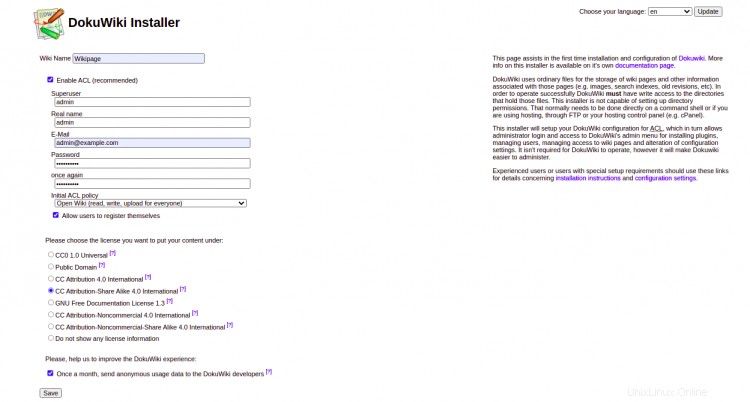
Proporcione su nombre de wiki, nombre de usuario de administrador, contraseña, correo electrónico, elija su política y haga clic en Guardar botón. Será redirigido a la siguiente página:
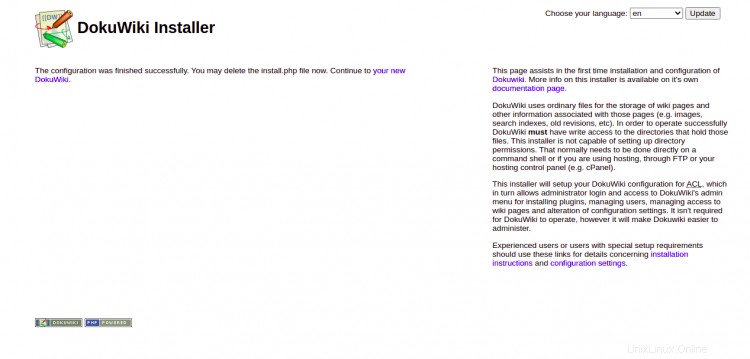
Haz clic en "tu nuevo DokuWiki ". Debería ver la siguiente pantalla:
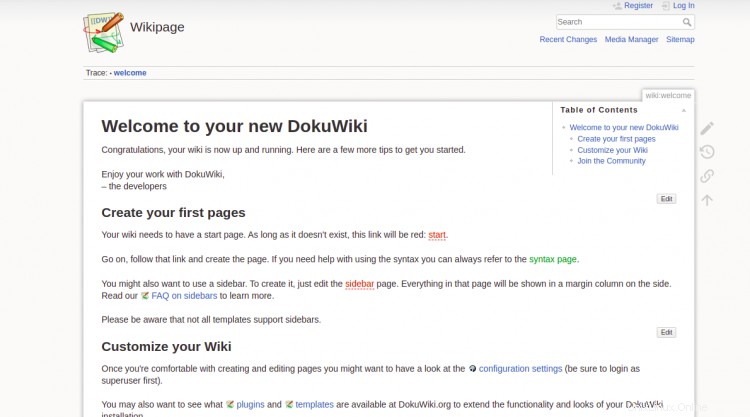
Haga clic en Iniciar sesión botón. Será redirigido a la pantalla de inicio de sesión de DokuWiki como se muestra a continuación:
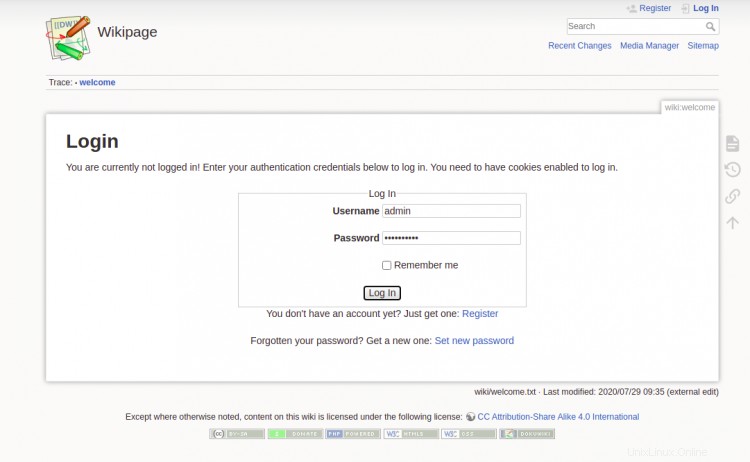
Proporcione su nombre de usuario y contraseña de administrador y haga clic en Iniciar sesión botón. Deberías ver el panel de DokuWiki en la siguiente pantalla:
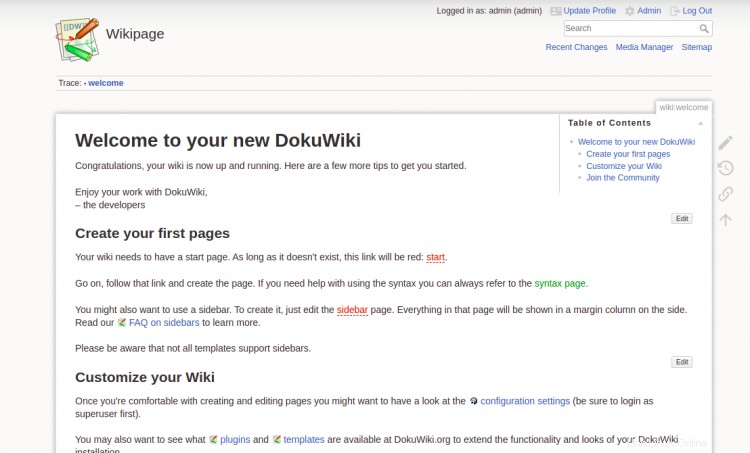
Conclusión
¡Felicidades! Ha instalado correctamente DokuWiki y lo ha asegurado con Let's Encrypt SSL en Debian 11. Ahora puede comenzar a crear su primer sitio web con DokuWiki. Siéntase libre de preguntarme si tiene alguna pregunta.